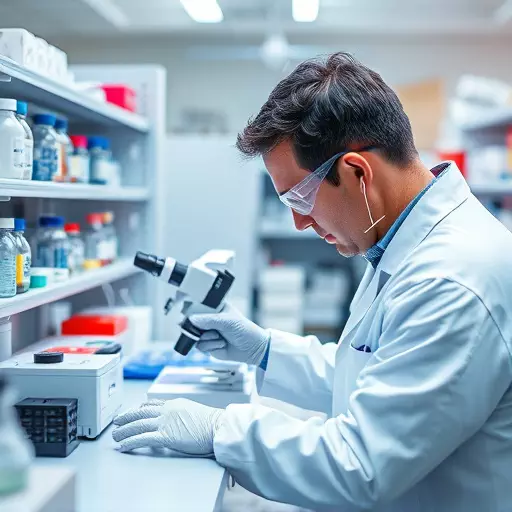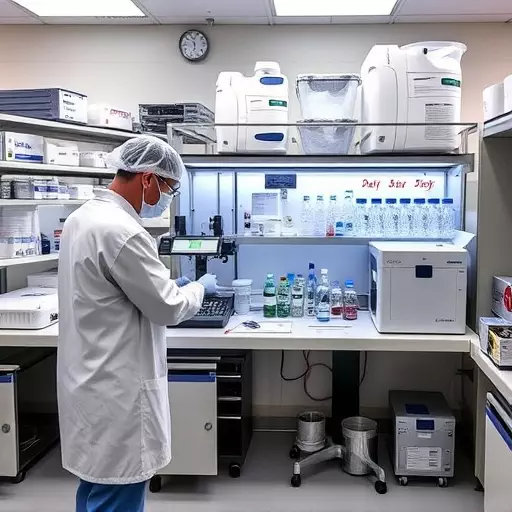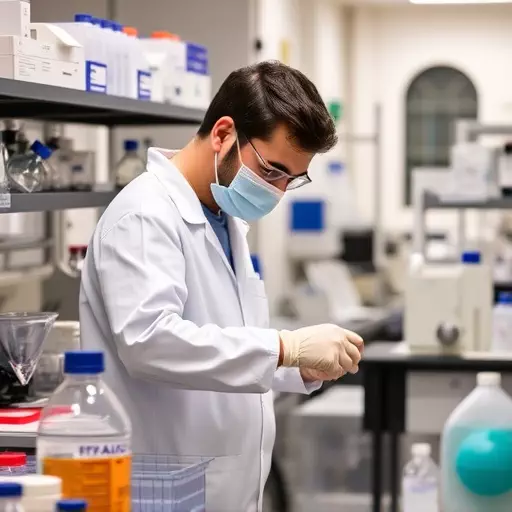Forensic analysis in Bloomington-Bedford leverages advanced DNA sequencing and lab automation technologies for faster, more accurate investigations. DNA sequencing aids in identifying suspects through genetic material matching, while automation streamlines tasks for enhanced efficiency. These innovations revolutionize casework, providing precise details to resolve complex crimes swiftly. When seeking lab services, prioritize facilities with cutting-edge tech like DNA sequencing and automation, ensuring superior results and effective find lab work in Bloomington-Bedford.
Forensic analysis plays a pivotal role in solving complex crimes by unearthing critical evidence. This article delves into various facets of forensic science, offering insights from understanding fundamental principles to exploring cutting-edge innovations. We examine the power of DNA sequencing in investigations, highlight how lab automation streamlines and enhances lab work in Bloomington-Bedford, and provide practical tips for residents seeking reliable forensic laboratory services. Additionally, we outline a step-by-step guide from evidence collection to data interpretation and discuss future trends shaping this dynamic field.
- Understanding Forensic Analysis: Unraveling Complex Crimes
- The Role of DNA Sequencing in Forensic Investigations
- How Lab Automation Transforms Forensic Lab Work
- Finding the Right Forensic Laboratory: Tips for Bloomington-Bedford Residents
- From Evidence Collection to Data Interpretation: A Step-by-Step Guide
- Future Trends: Innovations in Forensic Analysis and Their Impact
Understanding Forensic Analysis: Unraveling Complex Crimes

Forensic analysis is a complex and intricate process that involves the application of scientific methods to unravel the details of criminal investigations. It’s a crucial aspect of finding justice, as it helps to piece together evidence from crime scenes, identify suspects, and even determine the sequence of events leading up to an incident. By delving into lab work in Bloomington-Bedford, experts employ cutting-edge technologies like DNA sequencing and lab automation to expedite and enhance their analyses.
DNA sequencing, for instance, plays a pivotal role in forensic science by allowing investigators to match genetic material found at the scene to potential suspects or victims. Lab automation streamlines various tasks, from sample preparation to data analysis, ensuring efficiency and accuracy. This innovative approach not only expedites investigations but also opens doors to more detailed insights, thereby helping to solve complex crimes with greater precision and speed.
The Role of DNA Sequencing in Forensic Investigations

Forensic investigations have seen a paradigm shift with the advent of advanced DNA sequencing technologies. In the lab work in Bloomington-Bedford, researchers leverage DNA sequencing to uncover crucial insights from crime scenes and biological evidence. This powerful tool enables them to identify individuals, establish genetic relationships, and even pinpoint specific contributors to contaminated samples, significantly enhancing the accuracy and scope of forensics.
DNA sequencing, combined with lab automation, streamlines the process, making it faster and more efficient. Automation reduces manual errors, ensures consistency in sample handling, and allows for high-throughput analysis. This technological integration is transforming how forensic scientists approach casework, providing them with unparalleled precision and detail to resolve complex investigations.
How Lab Automation Transforms Forensic Lab Work

In the realm of forensic analysis, the integration of lab automation is revolutionizing the way experts conduct investigations in find lab work in Bloomington-Bedford. Automation technologies streamline various processes, enhancing efficiency and accuracy. One of the most significant advantages is the automatization of DNA sequencing, a critical component in many forensic cases. By employing robotic systems, labs can process vast amounts of genetic data with unparalleled precision, enabling quicker analysis of evidence from crimescenes.
This technological shift not only expedites case resolution but also improves the overall quality of findings. Automated systems minimize human errors that can occur during manual tasks, ensuring consistent and reliable results. In addition, automation frees up forensic scientists to focus on more complex aspects of their work, fostering a more strategic approach to solving criminal cases. Thus, lab automation becomes an indispensable tool in modern forensics, setting new standards in accuracy and speed, especially when seeking justice in Bloomington-Bedford.
Finding the Right Forensic Laboratory: Tips for Bloomington-Bedford Residents

When it comes to finding the right forensic laboratory for your needs in Bloomington-Bedford, residents should look beyond location alone. While accessibility is key, the quality and capabilities of lab services are equally important. Reputable labs offering advanced technologies like DNA sequencing and lab automation can provide faster, more accurate results, ensuring justice is served.
Consider researching facilities that cater to a range of forensic needs, from toxicology reports to digital forensics. Check their credentials, experience with local cases, and customer reviews to make an informed decision. Remember, the right laboratory can make all the difference in the efficiency and integrity of your case workup, so take the time to find a lab that aligns with your requirements in Bloomington-Bedford.
From Evidence Collection to Data Interpretation: A Step-by-Step Guide

Forensic analysis is a meticulous process that begins with evidence collection and culminates in data interpretation. The journey starts when investigators meticulously gather physical evidence, ensuring its integrity and proper documentation. This often involves finding lab work in Bloomington-Bedford, where skilled professionals employ advanced techniques to prepare samples for analysis. DNA sequencing is a cornerstone of forensic science, enabling the extraction and comparison of genetic information from various sources.
As technology evolves, lab automation plays an increasingly significant role, streamlining tasks like sample processing and data entry. This automation not only enhances efficiency but also reduces human error, ensuring consistent and accurate results. Each step in this intricate process demands precision and adherence to strict protocols, ultimately contributing to the reliability of forensic findings in legal proceedings.
Future Trends: Innovations in Forensic Analysis and Their Impact

The future of forensic analysis is brimming with innovative developments that promise to transform investigations and improve justice systems worldwide. One of the most significant trends is the increasing integration of advanced technologies, such as DNA sequencing and lab automation, into routine lab work in Bloomington-Bedford. These innovations are set to enhance accuracy and efficiency, allowing for faster and more detailed analyses of physical evidence.
DNA sequencing techniques are evolving rapidly, enabling scientists to extract and analyze genetic information from increasingly smaller samples, including those previously considered inadequate. Lab automation is also revolutionizing the process by streamlining tasks, reducing human error, and minimizing the time required for complex procedures. These trends will undoubtedly impact forensic practices globally, leading to more robust crime scene investigations and improved outcomes in legal proceedings.
